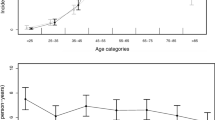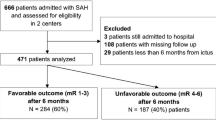Abstract
Background
There is a paucity of reliable and recent data regarding epidemiology of non-aneurysmal subarachnoid hemorrhage (SAH) in population-based studies.
Objectives
To determine the incidence and case fatality of non-aneurysmal SAH using a population-based design.
Methods
Medical records and angiographic data of all patients from Stearns and Benton Counties, Minnesota, admitted with SAH were reviewed to identify incident case of non-aneurysmal SAH. Patients with a first-time diagnosis of non-aneurysmal SAH (based on two negative cerebral angiograms performed ≥7 days apart) between June 1st, 2012 and June 30th, 2014 were considered incident cases. We calculated the incidences of non-aneurysmal and aneurysmal SAH adjusted for age and sex based on the 2010 US census.
Results
Of the 18 identified SAH among 189,093 resident populations, five were true incident cases of non-aneurysmal SAH in this population-based study. The age- and sex-adjusted incidence of non-aneurysmal SAH were 2.8 [95 % confidence interval (CI) 2.7–2·9] per 100,000 person-years which was lower than aneurysmal SAH incidence of 7.2 [95 % CI 7.1–7.4] per 100,000 person-years. The age-adjusted incidence of non-aneurysmal SAH was similar (compared with aneurysmal SAH) among men; 3.2 [95 % CI 3.1–3.3] per 100,000 person-years versus 2.2 [95 % CI 2.1–2.3] per 100,000 person-years, respectively. The age-adjusted case fatality rate at 3 months was 4.46 and 0.0 per 100,000 persons for aneurysmal and non-aneurysmal SAH, respectively.
Conclusions
The incidence of non-aneurysmal SAH was higher than previously reported particularly among men.
Similar content being viewed by others
References
de Rooij NK, Linn FH, van der Plas JA, Algra A, Rinkel GJ. Incidence of subarachnoid haemorrhage: a systematic review with emphasis on region, age, gender and time trends. J Neurol Neurosurg Psychiatry. 2007;78:1365–72.
Lindekleiv HM, Njolstad I, Ingebrigtsen T, Mathiesen EB. Incidence of aneurysmal subarachnoid hemorrhage in Norway, 1999–2007. Acta Neurol Scand. 2011;123:34–40.
ACROSS Group. Epidemiology of aneurysmal subarachnoid hemorrhage in Australia and New Zealand: incidence and case fatality from the Australasian Cooperative Research on Subarachnoid Hemorrhage Study (ACROSS). Stroke. 2000;31:1843–50.
Ishihara H, Kunitsugu I, Nomura S, et al. Seasonal variation in the incidence of aneurysmal subarachnoid hemorrhage associated with age and gender: 20-year results from the Yamaguchi cerebral aneurysm registry. Neuroepidemiology. 2013;41:7–12.
Qureshi AI, Vazquez G, Tariq N, Suri MF, Lakshminarayan K, Lanzino G. Impact of International Subarachnoid Aneurysm Trial results on treatment of ruptured intracranial aneurysms in the United States. Clinical article. J Neurosurg. 2011;114:834–41.
Inagawa T. Trends in surgical and management outcomes in patients with aneurysmal subarachnoid hemorrhage in Izumo city, Japan, between 1980–1989 and 1990–1998. Cerebrovasc Dis. 2005;19:39–48.
Pobereskin LH. Incidence and outcome of subarachnoid haemorrhage: a retrospective population based study. J Neurol Neurosurg Psychiatry. 2001;70:340–3.
Ronne-Engstrom E, Enblad P, Gal G, et al. Patients with spontaneous subarachnoid haemorrhage—presentation of a 10-year hospital series. Br J Neurosurg. 2009;23:499–506.
Sacco S, Totaro R, Toni D, Marini C, Cerone D, Carolei A. Incidence, case-fatalities and 10-year survival of subarachnoid hemorrhage in a population-based registry. Eur Neurol. 2009;62:155–60.
Qureshi AI, Chaudhry SA, Rodriguez GJ, Suri MF, Lakshminarayan K, Ezzeddine MA. Outcome of the ‘Drip-and-Ship’ paradigm among patients with acute ischemic stroke: results of a statewide study. Cerebrovasc Dis Extra. 2012;2:1–8.
Qureshi AI, Chaudhry SA, Majidi S, Grigoryan M, Rodriguez GJ, Suri MF. Population-based estimates of neuroendovascular procedures: results of a state-wide study. Neuroepidemiology. 2012;39:125–30.
Surveillance, epidemiology, and end results program-turning cancer data into discovery. National Institutes of Health: Bethesda.
Missouri Department of Health adn Seniour Services. Missouri 1999. NIH publication 99–4564.
Khan AA, Smith JD, Kirkman MA, et al. Angiogram negative subarachnoid haemorrhage: outcomes and the role of repeat angiography. Clin Neurol Neurosurg. 2013;115:1470–5.
Lin N, Zenonos G, Kim AH, et al. Angiogram-negative subarachnoid hemorrhage: relationship between bleeding pattern and clinical outcome. Neurocrit Care. 2012;16:389–98.
Andaluz N, Zuccarello M. Yield of further diagnostic work-up of cryptogenic subarachnoid hemorrhage based on bleeding patterns on computed tomographic scans. Neurosurgery. 2008;62:1040–6 discussion 7.
Rosner J, Nuno M, Miller C, et al. Subarachnoid hemorrhage patients: to transfer or not to transfer? Neurosurgery. 2013;60(Suppl 1):98–101.
Samuels O, Webb A, Culler S, Martin K, Barrow D. Impact of a dedicated neurocritical care team in treating patients with aneurysmal subarachnoid hemorrhage. Neurocrit Care. 2011;14:334–40.
Drazin D, Rosner J, Nuno M, et al. Type of admission is associated with outcome of spontaneous subarachnoid hemorrhage. Int J Stroke. 2013;. doi:10.1111/ijs.12005.
Catalano AR, Winn HR, Gordon E, Frontera JA. Impact of interhospital transfer on complications and outcome after intracranial hemorrhage. Neurocrit Care. 2012;17:324–33.
Anderson GB, Steinke DE, Petruk KC, Ashforth R, Findlay JM. Computed tomographic angiography versus digital subtraction angiography for the diagnosis and early treatment of ruptured intracranial aneurysms. Neurosurgery. 1999;45:1315–20 discussion 20-2.
Siddiq F, Adil MM, Kainth D, Moen S, Qureshi AI. The emergence of endovascular treatment-only centers for treatment of intracranial aneurysms in the United States. J Stroke Cerebrovasc Dis. 2013;22:e504–10.
Allen GS, Ahn HS, Preziosi TJ, et al. Cerebral arterial spasm–a controlled trial of nimodipine in patients with subarachnoid hemorrhage. New Engl J Med. 1983;308:619–24.
Philippon J, Grob R, Dagreou F, Guggiari M, Rivierez M, Viars P. Prevention of vasospasm in subarachnoid haemorrhage. A controlled study with nimodipine. Acta Neurochir. 1986;82:110–4.
Petruk KC, West M, Mohr G, et al. Nimodipine treatment in poor-grade aneurysm patients. Results of a multicenter double-blind placebo-controlled trial. J Neurosurg. 1988;68:505–17.
Haley EC Jr, Kassell NF, Torner JC, Truskowski LL, Germanson TP. A randomized trial of two doses of nicardipine in aneurysmal subarachnoid hemorrhage. A report of the Cooperative Aneurysm Study. J Neurosurg. 1994;80:788–96.
Bradford CM, Finfer S, O’Connor A, et al. A randomised controlled trial of induced hypermagnesaemia following aneurysmal subarachnoid haemorrhage. Crit Care Resusc. 2013;15:119–25.
Dorhout Mees SM, Algra A, Vandertop WP, et al. Magnesium for aneurysmal subarachnoid haemorrhage (MASH-2): a randomised placebo-controlled trial. Lancet. 2012;380:44–9.
Lanzino G, Kassell NF. Double-blind, randomized, vehicle-controlled study of high-dose tirilazad mesylate in women with aneurysmal subarachnoid hemorrhage. Part II. A cooperative study in North America. J Neurosurg. 1999;90:1018–24.
Haley EC Jr, Kassell NF, Apperson-Hansen C, Maile MH, Alves WM. A randomized, double-blind, vehicle-controlled trial of tirilazad mesylate in patients with aneurysmal subarachnoid hemorrhage: a cooperative study in North America. J Neurosurg. 1997;86:467–74.
Haley EC Jr, Kassell NF, Torner JC. A randomized controlled trial of high-dose intravenous nicardipine in aneurysmal subarachnoid hemorrhage. A report of the Cooperative Aneurysm Study. J Neurosurg. 1993;78:537–47.
Shen J, Pan JW, Fan ZX, Xiong XX, Zhan RY. Dissociation of vasospasm-related morbidity and outcomes in patients with aneurysmal subarachnoid hemorrhage treated with clazosentan: a meta-analysis of randomized controlled trials. J Neurosurg. 2013;119:180–9.
Macdonald RL, Higashida RT, Keller E, et al. Clazosentan, an endothelin receptor antagonist, in patients with aneurysmal subarachnoid haemorrhage undergoing surgical clipping: a randomised, double-blind, placebo-controlled phase 3 trial (CONSCIOUS-2). Lancet Neurol. 2011;10:618–25.
Gross BA, Lin N, Frerichs KU, Du R. Vasospasm after spontaneous angiographically negative subarachnoid hemorrhage. Acta Neurochir. 2012;154:1127–33.
Commerce USDo. State & County Quick Facts. United States Census Bureau. Online: Census Bureau; 2014.
Conflict of interest
The authors declare that they have no conflict of interest.
Financial Disclosure
Dr. Qureshi has received funding from the National Institutes of Health RO1-NS44976-01A2 (medication provided by ESP Parma), American Heart Association Established Investigator Award 0840053N, National Institute of Health U01-NS062091-01A2, and the Minnesota Medical Foundation, Minneapolis, MN.
Author information
Authors and Affiliations
Corresponding author
Rights and permissions
About this article
Cite this article
Qureshi, A.I., Jahangir, N., Qureshi, M.H. et al. A Population-Based Study of the Incidence and Case Fatality of Non-aneurysmal Subarachnoid Hemorrhage. Neurocrit Care 22, 409–413 (2015). https://doi.org/10.1007/s12028-014-0084-7
Published:
Issue Date:
DOI: https://doi.org/10.1007/s12028-014-0084-7




